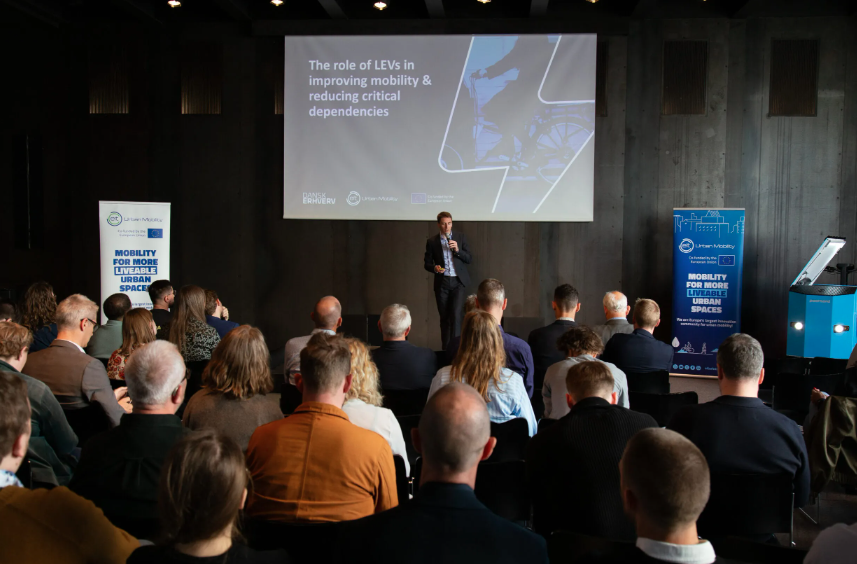Light Electric Vehicles Powering Green Mobility

Have you ever considered how light electric vehicles (LEVs) – like e-bikes, e-scooters, and e-cargo bikes – could help power active mobility, healthy cities and local businesses?
This question was at the heart of the Nordic conference on light electric vehicles, held on 8 May 2025 in Copenhagen by EIT Urban Mobility and Dansk Erhverv (Danish Chamber of Commerce). The event brought together cities, industry leaders, startup founders, researchers and other mobility experts to explore the potential of LEVs for transforming urban mobility.
Fewer critical materials and more circularity
Yoann Le Petit, Thought Leadership Manager at EIT Urban Mobility presented findings from a 2024 study by EIT Urban Mobility and EIT InnoEnergy, which emphasised the environmental advantages of LEVs, particularly in terms of material efficiency and battery sustainability.
Stronger circularity requirements will make LEV batteries more sustainable. […] LEVs will require 11–20 times less critical materials than electric cars (2030)
Yoann Le Petit, Thought Leadership Manager at EIT Urban Mobility
Circularity requirements from the European Union, such as battery passports and mandatory recycled content for batteries, will be implemented in the coming years.
Health effects of light electric vehicles
Reducing air pollution is another key reason to promote LEV adoption. “Everyone is exposed to harmful levels of air pollution, 96% of the population,” highlighted Zorana Jovanovic Andersen, Professor in Environmental Epidemiology at University of Copenhagen.
She pointed out a range of health impacts linked to air pollution – including lung disease, cancer, mental health disorders and dementia. LEVs support active mobility and can help mitigate these risks when paired with good infrastructure and equitable access.
Rethinking urban space: Fewer cars and more LEVs
We have to change the space between the buildings
Line Barfod, Mayor of Technical and Environmental Affairs at City of Copenhagen
Despite Copenhagen’s global reputation as a cycling city, car-centric infrastructure still dominates. Streets occupy 49% of public space, while bike paths make up just 6%. Reimagining the use of public space is essential to accommodate greener transport alternatives like LEVs.
Smarter integration with public transport
Making light electric vehicles (LEVs) a seamless part of public transport networks is key to boosting their adoption. Kolumbus, the public transport authority in Rogaland, Norway, offers a compelling example.
Our city bikes reduce up to 10,000 car journeys every month
Espen Strand Henriksen, Head of Mobility and Business Development
Kolumbus is pushing boundaries with initiatives like e-bike leasing for car-owning employees and combining bike rentals with public transport tickets–streamlining the experience to work through a single app. These kinds of integrations not only make sustainable choices easier but also more attractive.
Light electric vehicles for greener urban logistics
Urban deliveries are ripe for a sustainable transformation.
80% of Wolt’s carbon emissions come from courier deliveries
Jamieson Saab, Global Head of Sustainability at Wolt
In response, the company launched its Better Cities Programme, helping couriers lease electric vehicles to cut emissions and costs. The benefits are striking
'Delivery costs are 65% lower with a cargo bike than with a van' noted Hans Fogh, CEO and Co-Founder of Larry vs Harry, referencing successful pilots with major logistics firms like FedEx in Canada.
And it's not just about carbon and cost. “LEVs help our drivers avoid parking fines and navigate traffic faster,” added Morten Rahbek Keseler, Director at Bring Courier & Express. “Plus, they’re easier on the joints than traditional bikes.” From efficiency to ergonomics, LEVs are proving to be a smarter choice for last-mile delivery.


 Share this page
Share this page


